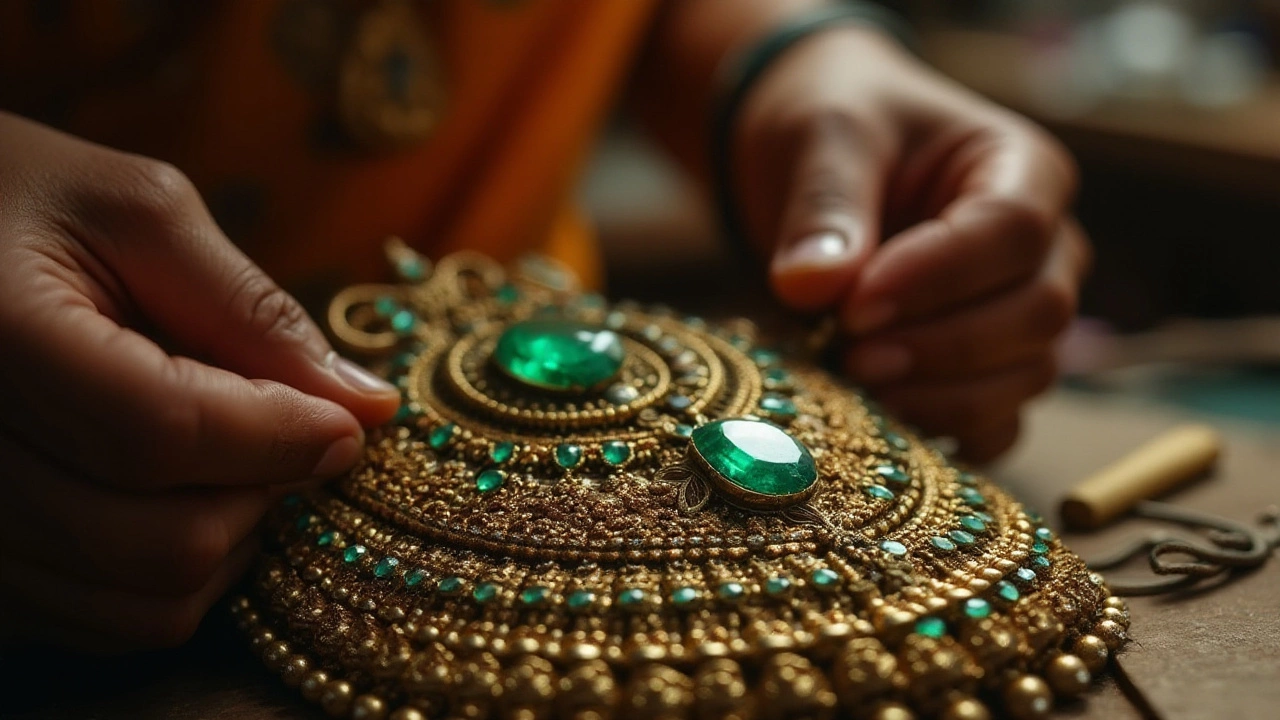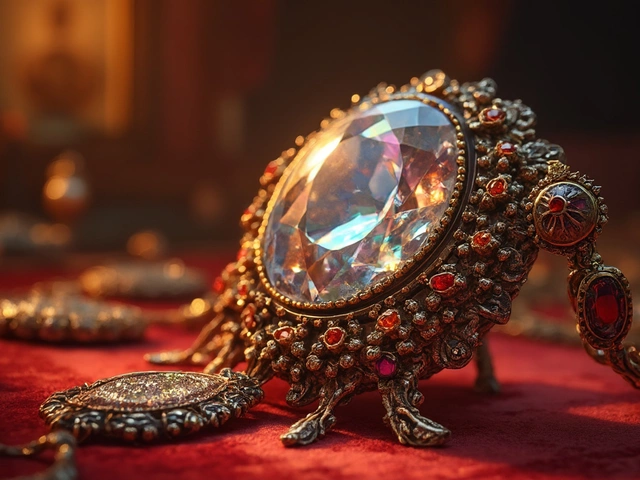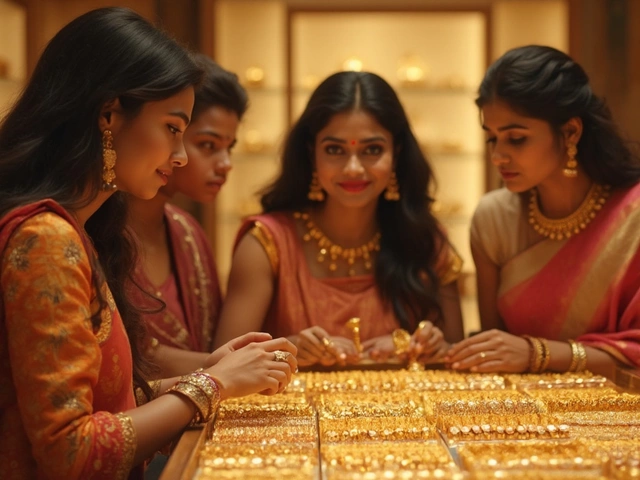
India's love affair with emeralds dates back centuries, woven deeply into the cultural and spiritual fabric of society. This enchanting gemstone, with its vibrant green allure, captures more than just the eye—it holds a revered place in Indian heritage, especially in the context of temple jewellery.
Historically celebrated for their beauty and mystic properties, emeralds have been a cornerstone in crafting jewellery that adorns the deities and decorates sacred spaces. They are not mere ornaments but are imbued with profound meanings and associations.
Understanding the nuances behind why Indians prize these stones provides insight into a rich tapestry of tradition and belief, as emeralds stand as enduring symbols of benevolence and divine connection.
- Historical Significance of Emeralds in India
- Cultural Value of Emeralds in Temple Jewellery
- Symbolism and Spiritual Beliefs
- Emeralds in Rituals and Festivities
- Caring for Your Temple Jewellery
Historical Significance of Emeralds in India
The allure of emeralds is deeply rooted in Indian history, stretching back to ancient times when these gemstones were celebrated for their vivid green hues and mystical properties. India, known as a land of precious stones, has always had a special place for emeralds, integrating them into the very meaning of opulence and spirituality. Long before the classical era, these stones were traded along the Silk Route and found their way into Indian palaces and treasures. The Harappan civilization, one of the earliest known to mankind, shows evidence of using emeralds in their jewellery, signifying wealth and status.
In the later periods, particularly during the reign of the Mughal Empire, emeralds gained prominence like never before. The Mughals, with their grand architectural endeavors and artistic grandeur, saw the potential of emeralds in enhancing the splendor of temple jewellery and royal adornments. The emperors, renowned for their discerning eye for beauty, extensively incorporated these stones into their personal collections as well as in eternal structures such as forts and tombs. According to historian William Dalrymple, "The Mughals' passion for gems is known to be boundless, yet their fascination with emeralds remains unparalleled".
The trade of emeralds further flourished under British colonial rule, as the British continued to capitalize on this lucrative commodity. India became a major hub for emerald processing and export, strengthening its position in the global gem trade. The trade relations established through emeralds also helped form diplomatic ties, bridging cultural gaps between different civilizations. This gemstone's journey through Indian history is not just about wealth but about acceptance and adaptation as belief systems evolved. The place of emeralds in India's spiritual landscape has roots that date back to these historical adoptions and transactions.
The Role of Emeralds in Culture and Trade
The cultural significance of emeralds in India is as varied as its regional diversity. In different parts of the country, these stones were believed to possess protective powers against evil forces and were often used in talismans and religious icons. This belief played into broader cultural practices, wherein emeralds were worn during ceremonies and crucial life events to invoke blessings and prosperity. The ancient texts of India, including the Vedas, have countless references to the use of emeralds, wherein they're associated with fertility and rebirth.
The Vedas describe emeralds as "gems of eternal spring," highlighting their transformative essence and protective qualities, linking them with the renewal of life and change.
The trade of emeralds was not limited by cultural demarcations, as Indian jewels found admirers across the Arabian and Central Asian territories. This cross-cultural admiration is well-documented, and the emeralds were woven into stories of fairy tales and folklore, often as an integral part of dowries and tributes. The Indian Ocean trade routes witnessed emeralds being transported to the wider world, symbolizing the wealth and riches of the subcontinent. Through these ancient exchanges, emeralds helped establish a narrative where India came to be recognized as a pivotal player in the world of precious stones, carving a niche for itself in temple jewellery design and production.
Cultural Value of Emeralds in Temple Jewellery
Emeralds hold a prestigious place in Indian temple jewellery, an ancient art form venerating deities through divine and exquisite adornments. The rich green hue of emeralds is often associated with fertility, rebirth, and renewal, concepts deeply ingrained in the Indian ethos. This symbolism aligns perfectly with the purpose of temple jewellery, crafted with the intention of celebrating and honoring the gods. Emeralds are thought to bring peace and an abundance of positive energy, thereby ennobling the idols they adorn. The allure of these gemstones is not merely aesthetic; it embodies the cultural and religious significance that elevates the vibrant traditions of India.
In many temples across the country, the adornment of idols with emeralds is a testament to faith and reverence. The process of bedecking gods with these precious stones is steeped in symbolism, representing the bestowal of wealth and divine favor. Historically, emeralds were favored by Indian royalty, whose patronage of temple jewels left a legacy of opulent and spiritually significant artefacts. These stones served as a material reflection of the kingdom's prosperity and the ruler's devotion. The emerald's connection with eloquence and foresight often sees it chosen for temple jewellery commissioned by patrons seeking blessings on their speech and wisdom. Some historians suggest that this cultural tradition might have expanded the appeal of emeralds beyond the boundaries of social and economic status.
In India, every region contributes uniquely to the art of temple jewellery, yet emeralds remain a common thread. The stunning pieces are compiled by local artisans who breathe life into the designs, balancing intricacy with symbolism. An example is the temple city of Madurai, where jewellers often incorporate these gemstones into the intricate patterns of the famous temple jewellery. Such pieces are not just jewels but represent the convergence of devotion, art, and history. It's important to recognize that this is a cultural practice continuing to evolve, while holding deep roots in ancient traditions. The fusion of craft and spirituality resonates through festivals and sacred ceremonies, inviting communities to celebrate heritage through these elaborate adornments.
"Emeralds in Indian jewellery are more than ornamental. These stones tell a story interwoven with age-old traditions, celebrating both the spiritual and cultural aspects of our society." – Dr. Maya Rao, Cultural Historian.Such insights provide a deeper understanding of why emeralds not only fascinate but are integral to the very essence of temple jewellery. Each transaction, history, and ritual exhibit the intertwining paths of spiritual journey and cultural expression. A recent survey indicated that almost 70% of traditional jewellery retailers in India consider emeralds a vital piece in their collection, highlighting their continuous appeal across generations.

Symbolism and Spiritual Beliefs
Emeralds hold a mystical charm that transcends their material value, especially within the context of Indian temple jewellery. For centuries, these gemstones have been associated with deep spirituality and profound symbolism, solidifying their reputation as more than mere decorative elements. The lush green hue of emeralds is often linked to universal symbols such as growth, renewal, and fertility, resonating deeply with the Indian ethos which cherishes life and rebirth. Many believe that these stones channel the energy of the planet Mercury, which is considered a benefactor of intellect and communication, therefore reflecting a harmonious blend of earthly and divine attributes.
In the sacred realm, emeralds are prominently embedded within the crowns and necklaces of gods and goddesses, symbolizing their divine wisdom and everlasting life. This practice not only amplifies the spiritual ambiance of religious ceremonies but also instills a sense of tranquility and peace among devotees. The stone's potent symbolism extends to its purported healing capabilities. It's said that emeralds can prevent ailments, balance energies, and even serve as a remedy for emotional turmoil. This belief is not just a modern-day notion but rather, an ancient trust passed through generations of cultural heritage. An emerald-studded icon within a temple isn't seen as merely an object, it's revered as an artifact that beckons good fortune and spiritual cleansing.
Historically, many sages and scholars have hailed emeralds for their metaphysical qualities. The Mughal Emperor Babur, for instance, cherished his collection of emeralds, which he believed were amulets against evil and bad luck. Reflecting on this era, it's fascinating to realize how stones have shaped not just fashion but also spiritual practices across centuries. It returns to the idea proposed by Indian philosopher and mystic, Osho, who once noted, "A stone is not just matter, it is energy... How beautiful that the energy can take this form."
This ancient wisdom reinforces the notion that emeralds, particularly within temple jewellery, are not just prized for their beauty but for their ability to bridge the mortal with the divine. This bridge is perceived through the rituals and daily practices of many devout individuals who believe emeralds augment meditation and spiritual awareness. Such stones are often considered particularly auspicious during specific astrological events or religious festivals, where their presence is thought to elevate spiritual vibrations and bestow blessings upon participants. Emeralds thus stand as versatile emissaries in Indian culture, echoing profound beliefs and transcending ordinary bounds to connect human faith with celestial forces.
Emeralds in Rituals and Festivities
Emeralds have always held a special place in Indian rituals and festivities, celebrated not only for their beauty but also for their believed spiritual powers. These lush green gemstones are often associated with growth, renewal, and profound creativity, ideas deeply rooted in the Indian consciousness.
During important festivals and celebrations, emeralds adorn not just the gods, but also the devotees who gather to pay their respects and seek blessings. Considered to be the 'stone of successful love', emeralds are often featured in wedding ceremonies, believed to bring harmony and joy to the newlyweds.
The practice of wearing emeralds extends to many religious ceremonies, where this gemstone's distinct hue is thought to connect the wearer with divine energies. Ancient texts suggest that emeralds have been used as offering stones in temples, laid at the feet of deities as symbols of reverence and devotion.
It is not just the general population but also rulers, priests, and historical figures who have gravitated towards emeralds, using them as talismans in ceremonies. Even today, many spiritual healers and practitioners consider emeralds to be powerful tools that transmit cosmic insights and provide healing vibrations to those embarking on spiritual journeys.
For festivals like Diwali, which is known as the festival of lights, wearing emerald-studded jewellery is seen as inviting prosperity, wisdom, and love. These beliefs are so ingrained that it is not uncommon to see generations pass down emerald-encrusted heirloom jewellery, instilling lasting legacies of hope and fortune.
“Emeralds hold the ultimate power to balance energies, fostering healing and growth,” says noted jewellery historian Shriya Deshmukh, highlighting the profound impact of these gemstones on Indian culture.
| Occasion | Role of Emeralds |
|---|---|
| Wedding Ceremonies | Symbolize love and loyalty |
| Diwali Festivities | Invite prosperity and wisdom |
| Temple Offerings | As acts of devotion |
Participating in these traditions is more than just a cultural act; it is a deeply personal experience, connecting individuals to their ancestors, communities, and spiritual beliefs through these radiant stones.

Caring for Your Temple Jewellery
Temple jewellery is far more than an accessory; it is a cherished heirloom, a piece of living history crafted with intricate details and often adorned with precious gemstones like emeralds. Caring for these treasures is not just about maintaining their physical appearance but also about preserving their cultural and emotional significance. To ensure they remain as resplendent as the day they were crafted, there are some essential practices you should follow. Keep in mind that these pieces are often handmade, and the delicate artistry requires gentle handling. Regularly cleaning your temple jewellery is imperative, as dirt and oils from your skin can build up over time, dulling their natural shine. Use a soft cloth and a gentle, non-abrasive cleaner specifically designed for jewellery. If you’re unsure, consulting a professional jeweller who specializes in Indian jewellery is an excellent option to avoid damage.
It's important to store each piece separately to prevent scratches or tangling. A good jewellery box lined with soft fabric or separate pouches is ideal. Humidity and moisture are not friends of temple jewellery, which can tarnish the metals and dull the gemstones. Store them in a cool, dry place, perhaps even with a silica gel packet to absorb excess moisture. One well-known fact is that emeralds, being softer than diamonds, require extra caution against scratches and cracks. Avoid exposing them to harsh chemicals or ultrasonic cleaners. Interestingly, in certain traditional practices, jewelers recommend oiling the emeralds occasionally with lanolin oil to maintain their deep green hue, but it is wise to seek professional advice for specific care instructions.
Another aspect to consider is the wearing of your temple jewellery. These exquisite pieces are often showcased during special occasions and religious events, such as festivals and weddings. They are, however, best worn after you've completed your makeup and hairstyling routines, as cosmetics and sprays can have adverse effects on their luster. When removing your jewellery, do so carefully and wipe them down to remove any residues. Many owners of temple jewellery pieces can recount stories of their heritage, and a saying often passed down through generations is highlighted by a famous jeweller who noted, "Wear these pieces with pride and care, for they carry not just stones but stories of our ancestors." In today's fast-paced world, it can be tempting to overlook these practices, but taking the time to care for your temple jewellery ensures that you preserve a piece of heritage for future generations to appreciate and love.


